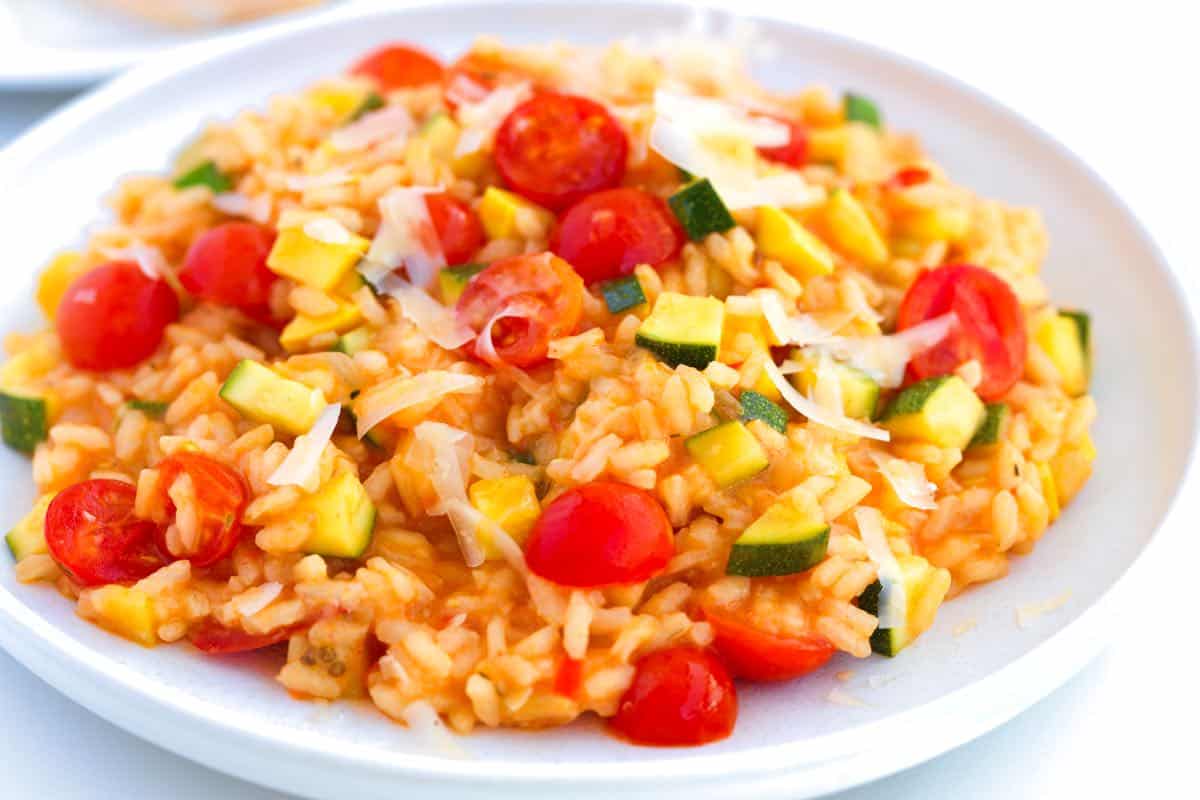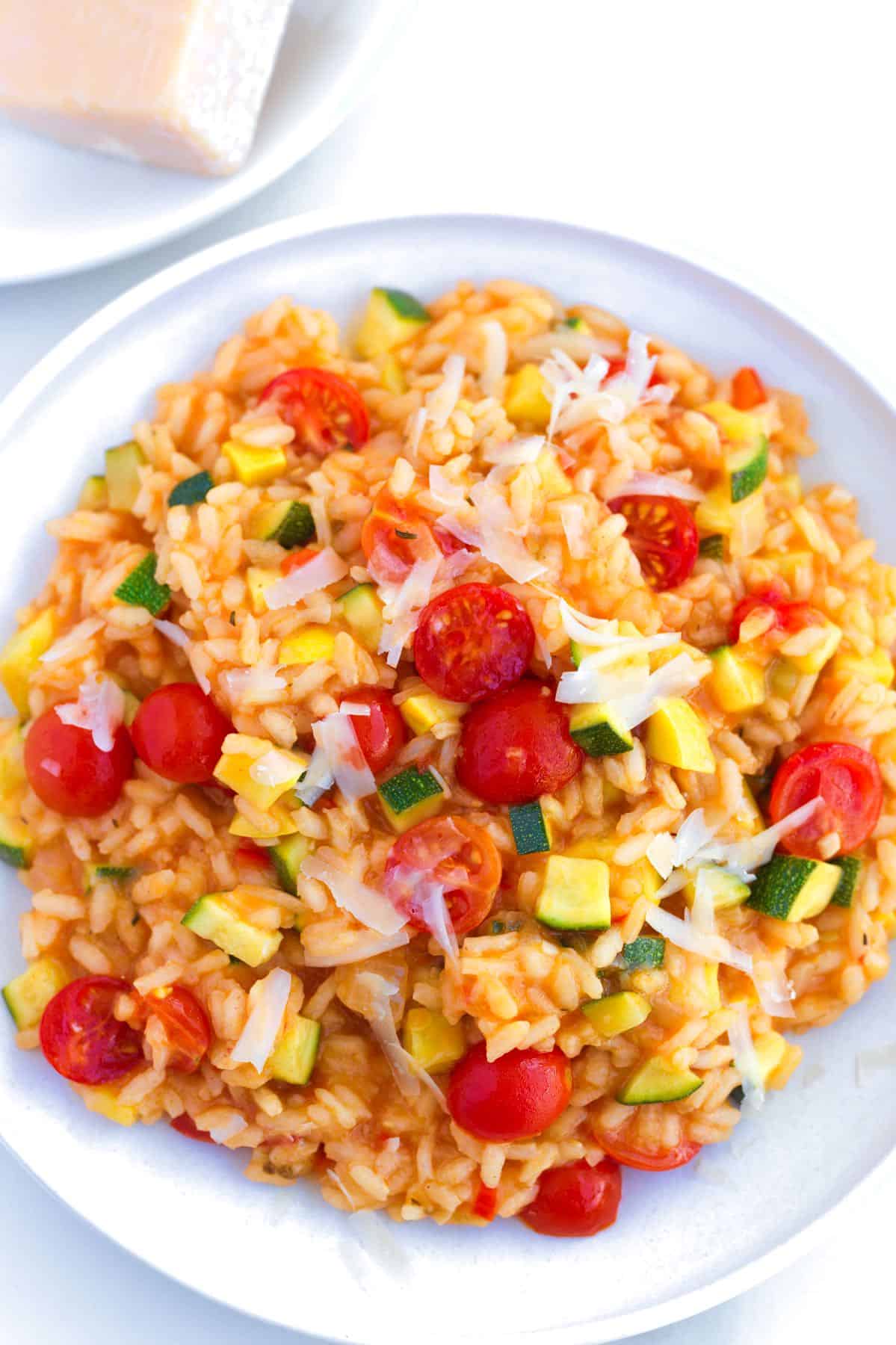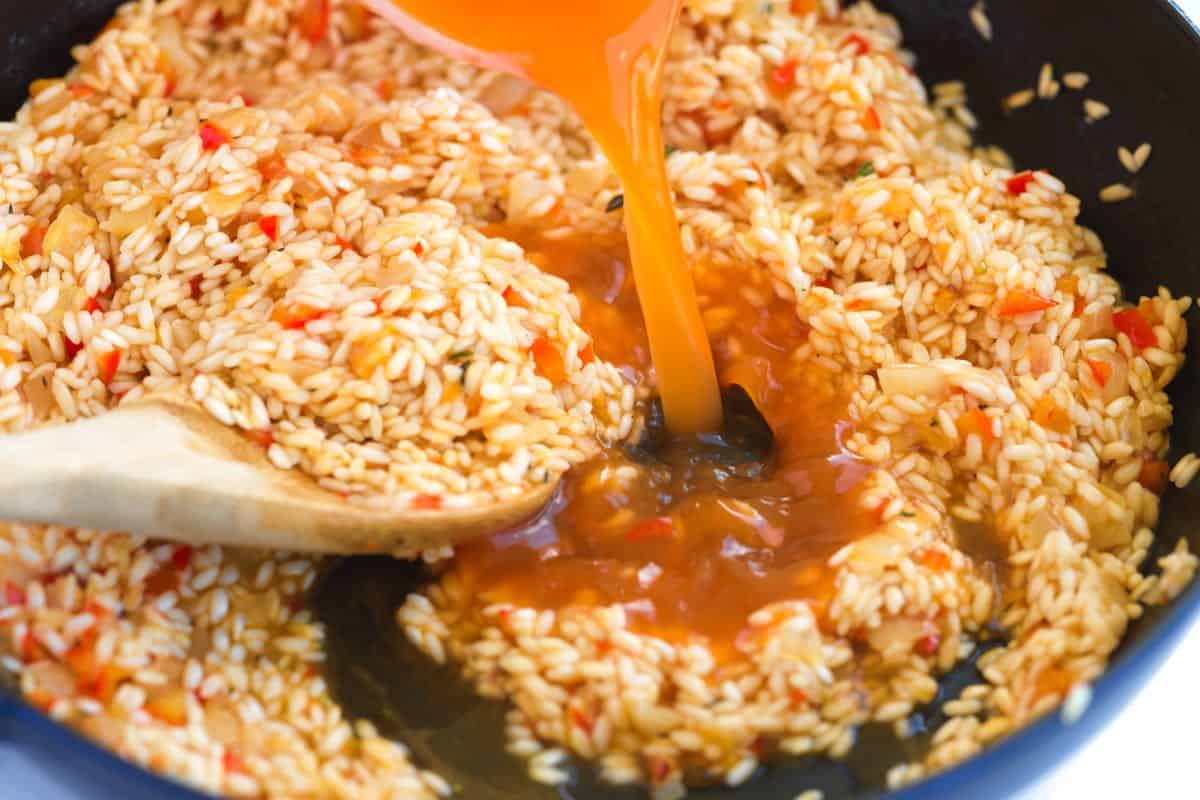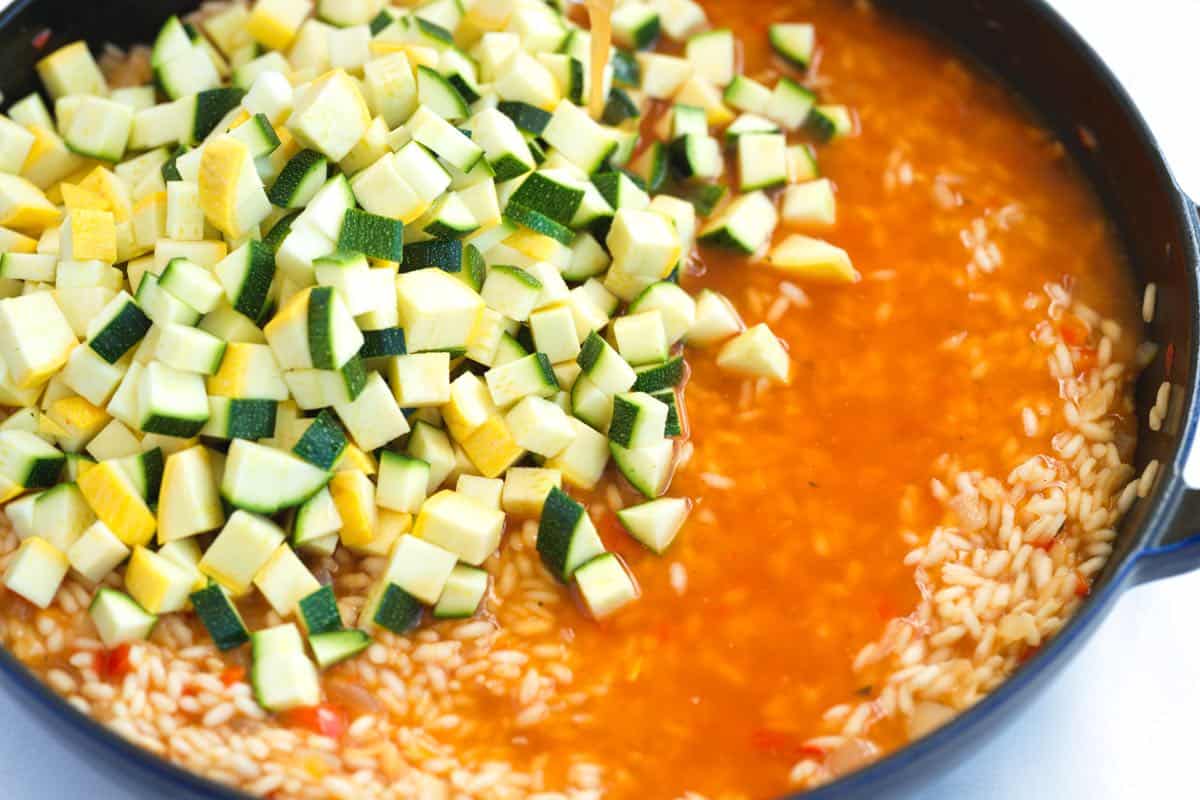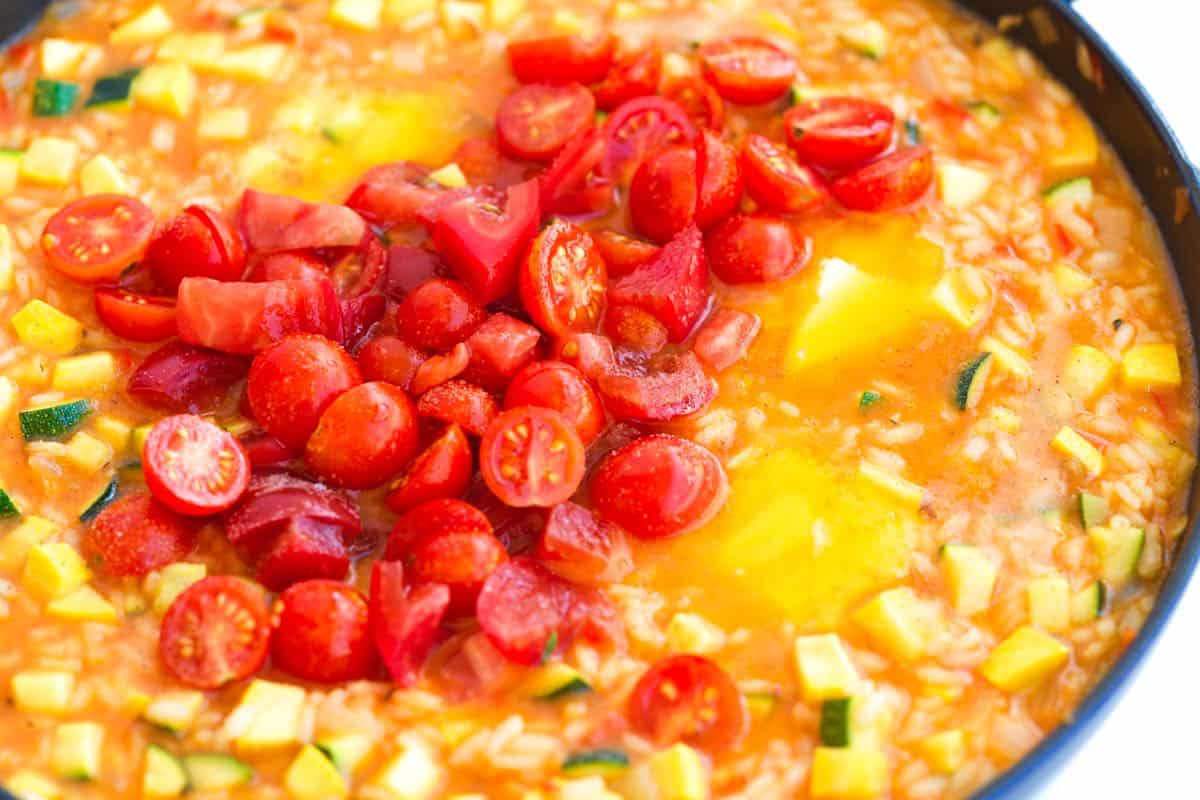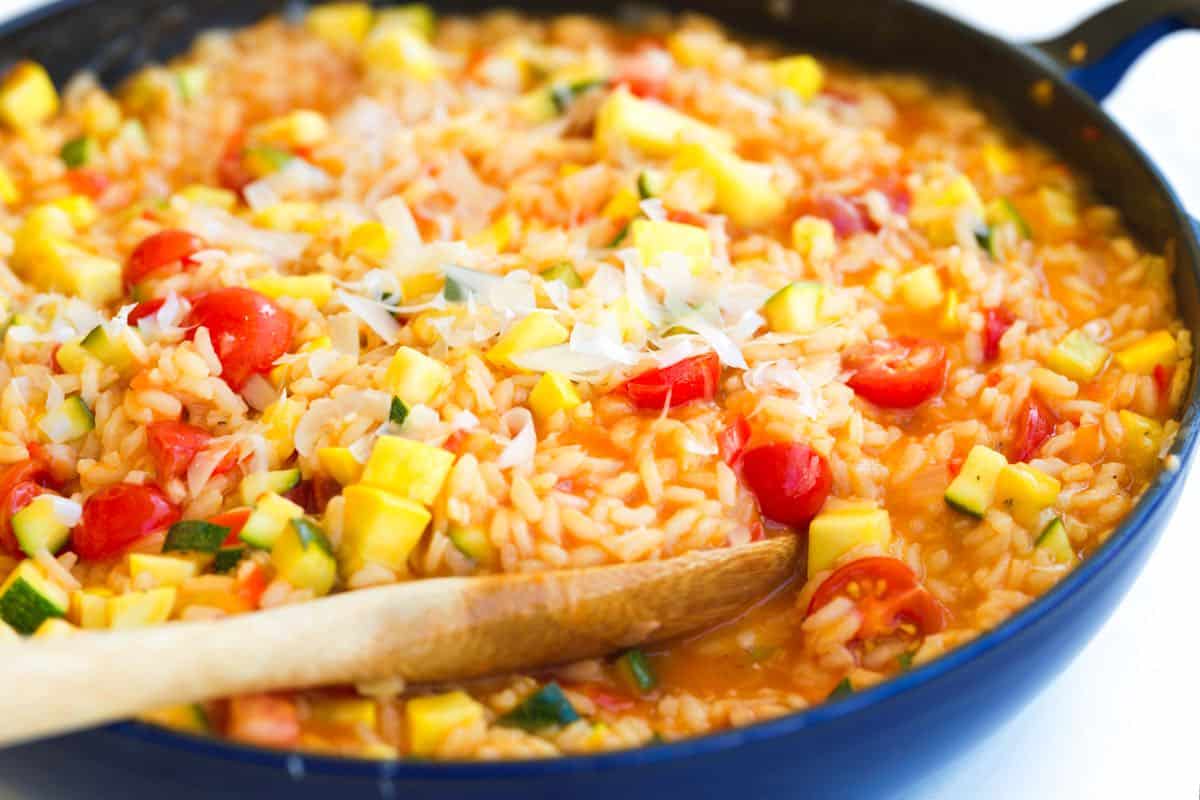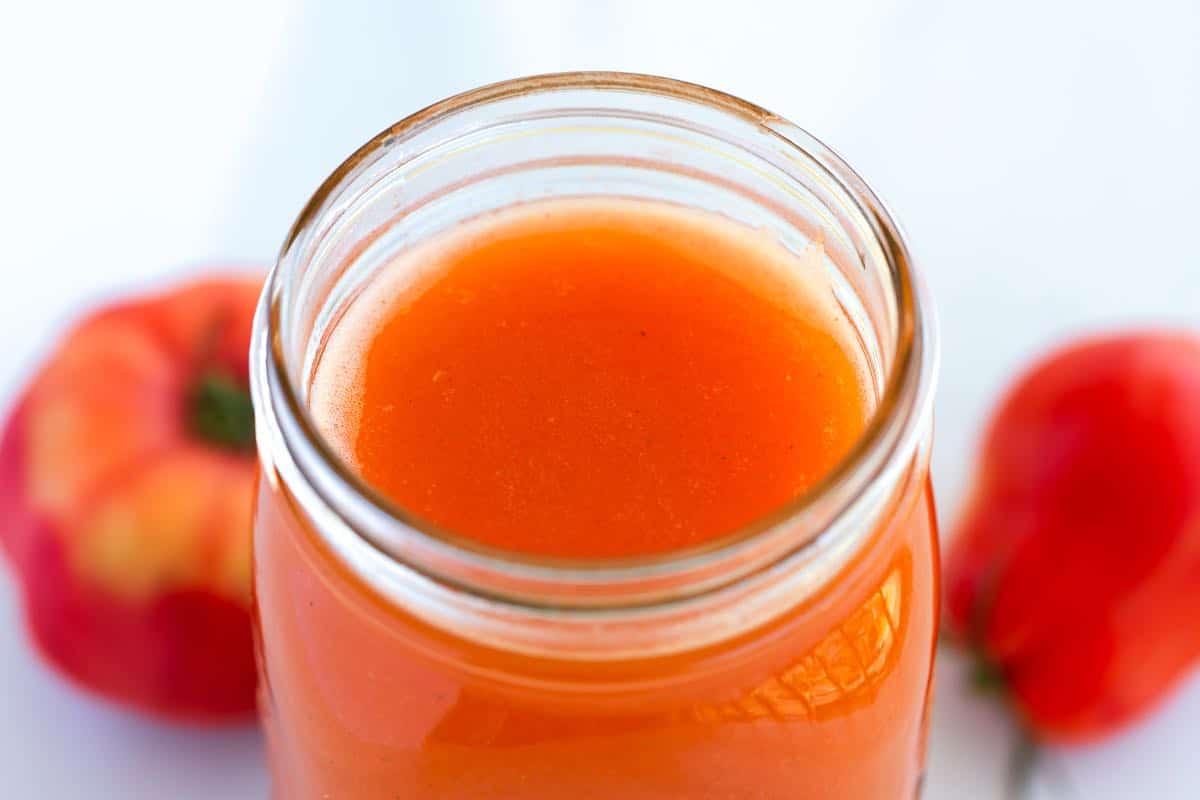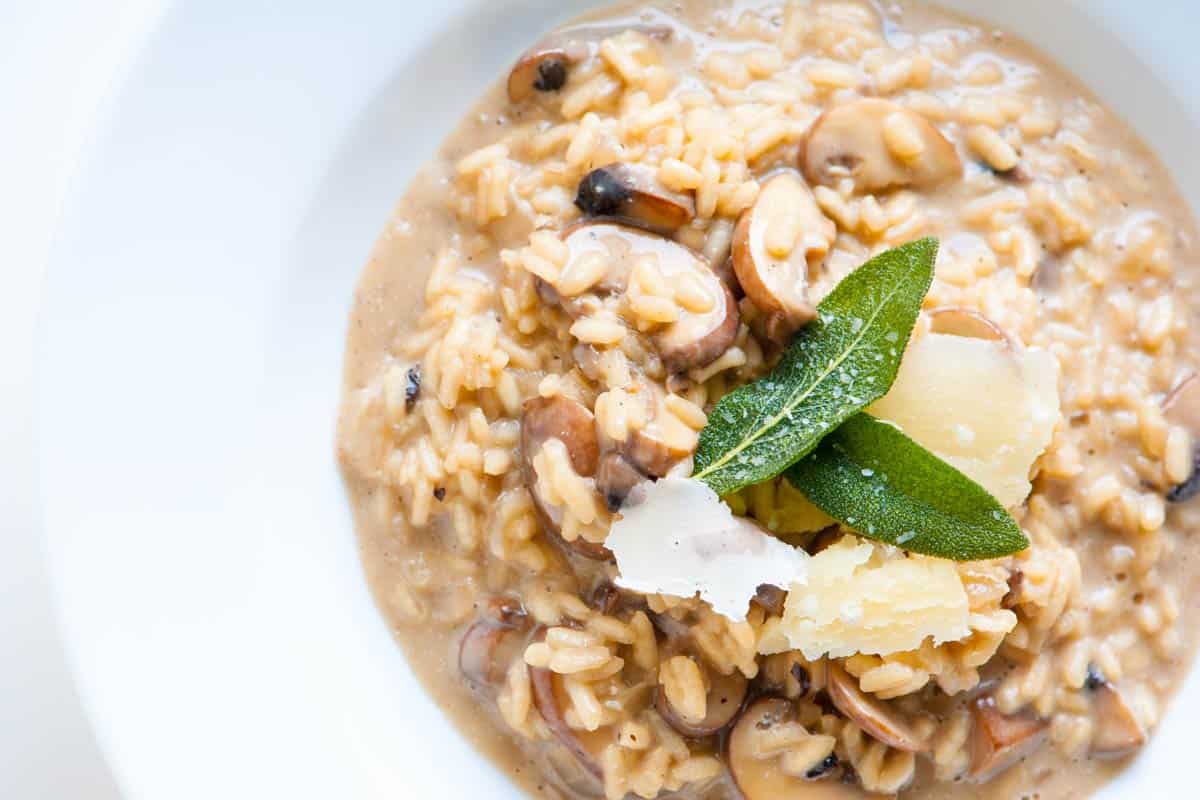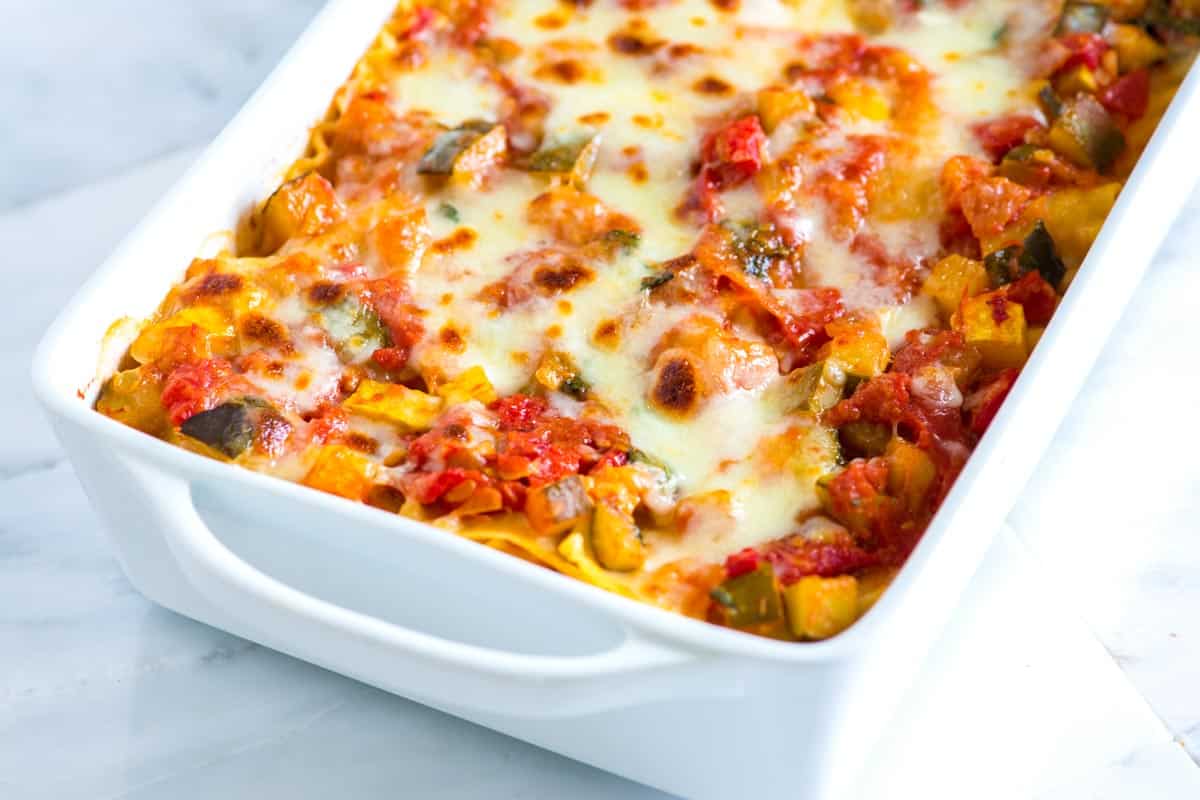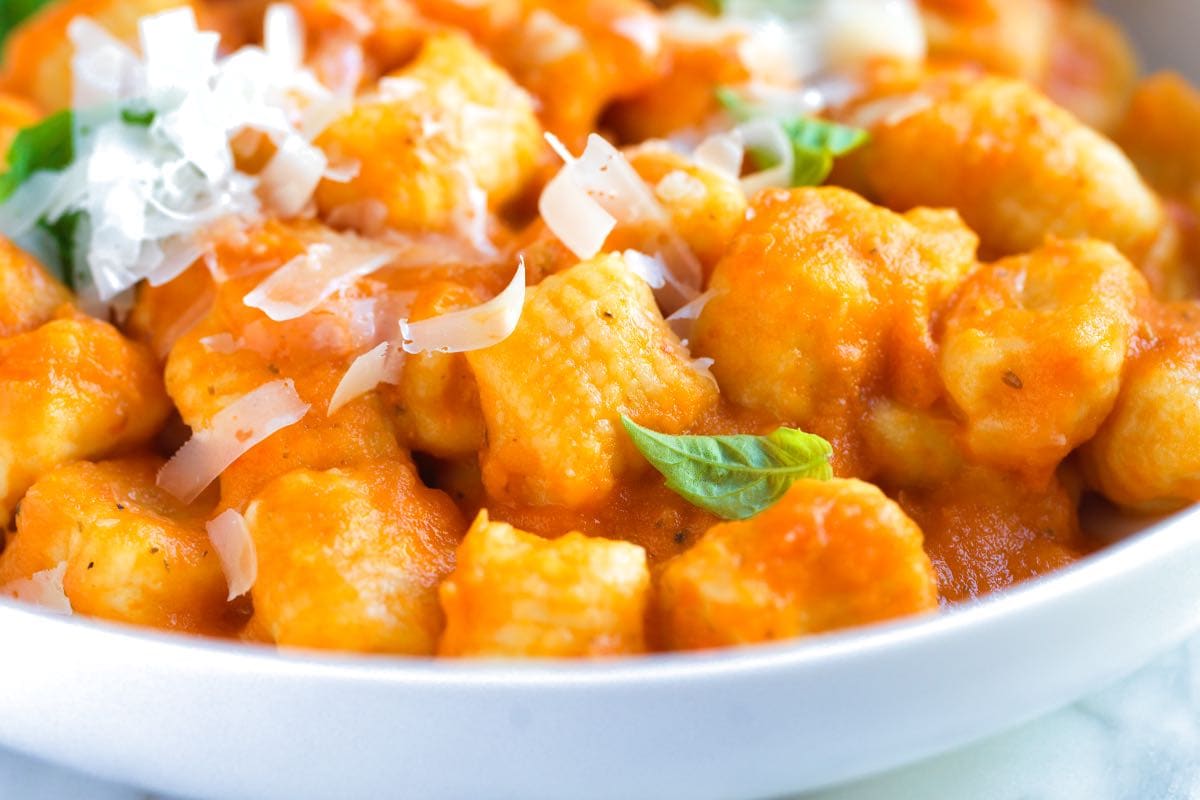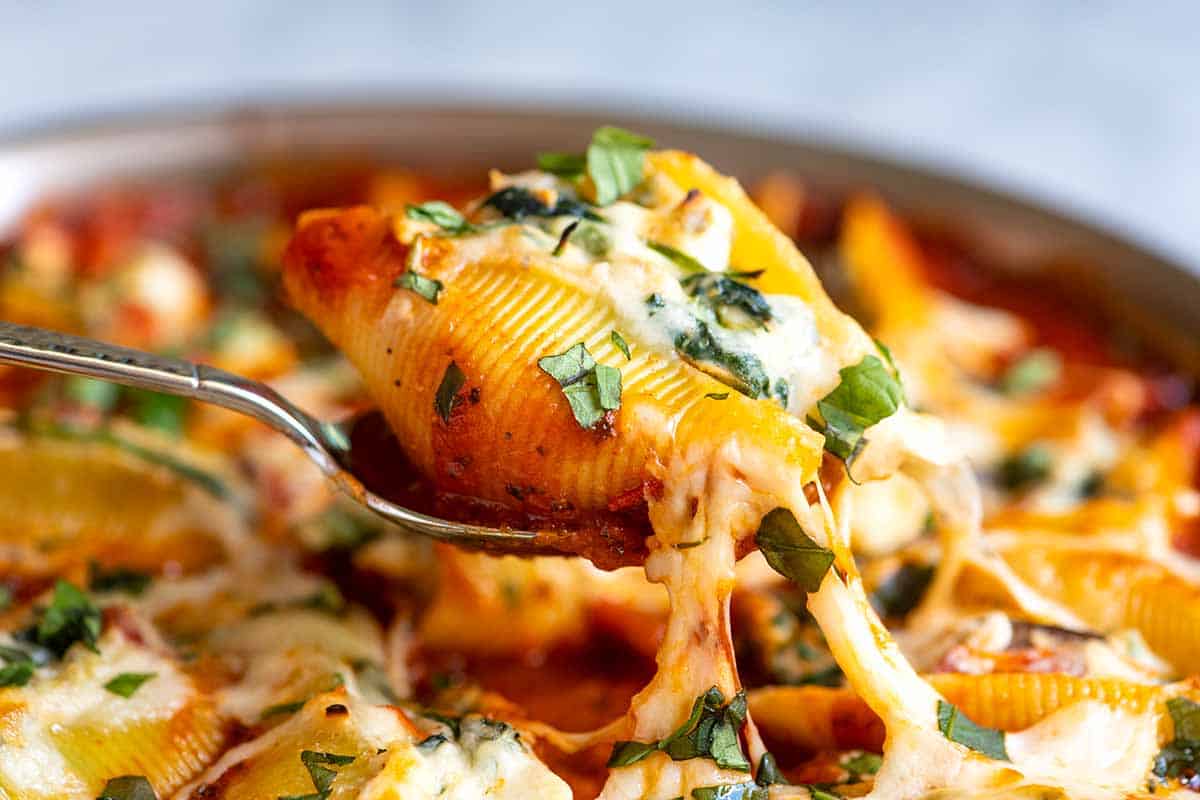We’re excited to share this vegetable risotto recipe developed with our chef friend, Richard Hattaway. Thanks to Richard’s restaurant trick, making risotto at home is now easier than ever. Instead of the usual continuous cooking, this recipe breaks the process into two stages. You can do most of the cooking up to 4 days ahead, then finish it in just 10 minutes right before serving. Of course, you can still make the recipe all at once if you prefer, but this two-stage method makes risotto much more convenient for busy schedules. For another risotto recipe, see our mushroom risotto.
Key Ingredients
Rice: The best rice for risotto are Arborio, Carnaroli, and Vialone Nano since they are all short-grain rice varieties with a high starch content. We use Carnaroli in our kitchen since it makes creamy risotto and is more forgiving when it comes to overcooking. Broth: A good vegetable broth and even chicken broth work perfectly well in this recipe, but we love our easy tomato broth for a summery tomato risotto base (that is what we have used in our photos). White Wine: Whenever you cook with wine, the most important thing to remember is to use something you enjoy. We use a light, dry white wine like Pino Gris, Albariño, Grüner Veltliner, or Sauvignon Blanc for this veggie risotto. Wine adds flavor and some acidity. If you prefer to leave it out, replace it with more broth and sprinkle a little fresh lemon juice over the risotto before serving. Veggies: We love risotto with veggies. You have some leeway when it comes to the vegetables. We use yellow squash, zucchini, tomatoes, eggplant, and fresh herbs. These are the same veggies we use to make our reader favorite veggie lasagna. Butter: There’s no cream in this risotto (thanks to the rice, it is creamy enough), but a generous pat of butter adds to the creamy, luxurious texture. For vegan risotto, use plant-based butter. Parmigiano-Reggiano: I’m generous with the cheese and recommend you do the same. For a vegetarian risotto, swap the Parmigiano-Reggiano for a vegetarian-friendly cheese like mozzarella, ricotta, or vegetarian parmesan. For vegan risotto, swap for a bit of nutritional yeast.
How to Make Vegetable Risotto
For risotto, you will need a wide, heavy-bottomed pan since it provides plenty of room for stirring. I also use a wooden spoon for risotto (a tip from Richard, who says wooden spoons help to create a creamier texture). Start by cooking onion, bell pepper, and garlic in olive oil until soft. Then stir in your risotto rice and toast it with the veggies and oil for a few minutes. Now pour in one cup of white wine and use a wooden spoon to stir everything around the pan a few times. Allow the wine to simmer away, and then pour in some broth. Again, you’ll want to stir the rice around the pan to make sure it isn’t sticking, and allow it to gently simmer in the broth until the liquid is mostly absorbed. We don’t need to stir constantly; just stir enough so nothing sticks to the pan. When the liquid is almost all absorbed, pour in more stock, allow it to simmer away (with a few stirs here and there), and then finish with a bit more broth. When the rice is almost tender but still raw in the center, it is 75% cooked. You have two options at this point: finish cooking the risotto or stop cooking and store it for later or another day. To save for later or another day (recommended if entertaining), take it off the heat, transfer it to a baking sheet, and cool it in the freezer. When it’s cool, transfer the rice to resealable containers and keep it in the fridge for up to 4 days. To finish the risotto, you will need about 10 minutes. Combine the rice mixture, chopped yellow squash, chopped zucchini, and a bit of broth in the same wide pan you used to cook the risotto in the first place. With your wooden spoon, stir the risotto often, ensuring nothing sticks to the bottom of the pan. Continue adding broth and stirring until the risotto is thick and creamy and the rice is barely tender. Finish by seasoning with salt and pepper and stirring in chopped fresh tomatoes. When the tomatoes are hot, drop in a big pat of butter and grate a generous amount of Parmigiano-Reggiano over the risotto. Serve with more cheese and fresh herbs on top. Optional eggplant puree (highly recommended): One thing Richard adds when making this vegetable risotto is eggplant puree. He stirs it in with the tomatoes. It’s simple to make and adds a smoky, umami flavor. We’ve included how to make eggplant puree in the recipe below if you’d like to include it. If you are entertaining, we highly recommend making the risotto in stages. First, cook it until 75% done, cool the rice mixture, and then about 10 minutes before serving, reheat and finish the risotto. This way, you are not standing over a hot stove for 30+ minutes when your guests are there. This method is written into the recipe below. 2 cups (380g) arborio rice or carnaroli rice 1 cup (236ml) dry white wine, see notes 1/4 cup (60ml) olive oil 1 cup finely chopped onion, half large onion 3/4 cup finely chopped red bell pepper, half large pepper 3 cloves garlic, minced 1 teaspoon fresh thyme leaves, chopped 1 medium yellow squash, chopped small 1 medium zucchini, chopped small 1 ¼ cups cherry tomatoes or use chopped tomatoes, 6 ounces 3 tablespoons salted butter Handful chopped fresh herbs like basil, chives, and green onion Parmigiano-Reggiano cheese for serving 2Add the rice and thyme and cook, stirring for 3 to 5 minutes. When the rice sticks a little, pour 1 cup of white wine into the pot. Stir the rice and wine around the pan with a wooden spoon until mostly dry. 3This step will take about 15 minutes: Begin by measuring out 3 ½ cups of broth, setting aside the remaining 2 ½ cups for later. Pour one third of the measured broth into the pan and keep the risotto at a low simmer while stirring often to prevent the rice from sticking. Once the pot becomes mostly dry, add another one third of the broth and repeat the process until all of the remaining stock has been added. 4The rice will be about 75% done and will be somewhat tender while still having a raw bite in the center. This is the end of stage one. Either cool the partially cooked risotto to finish later or move on to finishing the risotto. 2Grab the remaining 2 ½ cups of broth. Pour in a third of the broth. Then, with the wooden spoon, stir the rice mixture constantly, ensuring it doesn’t stick to the pan. Once the pot is mostly dry, add another one third of the broth and repeat the process until all of the remaining stock has been added. 3Season the vegetable risotto with 1 ½ teaspoons of fine sea salt, and stir in the tomatoes. 4Grate enough parmesan cheese over the top to cover the rice, add the butter, and finish with 5 twists of black pepper. Stir until the butter melts and the tomatoes are hot. The risotto should be creamy, the squash tender, and the tomatoes heated through. 5Serve immediately with fresh green herbs, green onion, and extra parmesan cheese on top.
